
Mayflies are aquatic insects belonging to the order Ephemeroptera. This order is part of an ancient group of insects termed the Palaeoptera, which also contains dragonflies and damselflies. Over 3,000 species of mayfly are known worldwide, grouped into over 400 genera in 42 families.

Baetidae is a family of mayflies with about 1000 described species in 110 genera distributed worldwide. These are among the smallest of mayflies, adults rarely exceeding 10 mm in length excluding the two long slender tails and sometimes much smaller, and members of the family are often referred to as small mayflies or small minnow mayflies. Most species have long oval forewings with very few cross veins but the hindwings are usually very small or even absent. The males often have very large eyes, shaped like turrets above the head.
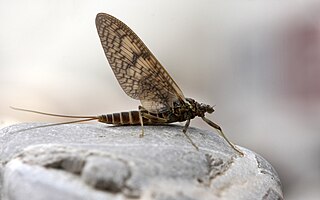
The Heptageniidae are a family of mayflies with over 500 described species mainly distributed in the Holarctic, Oriental, and Afrotropical regions, and also present in the Central American Tropics and extreme northern South America. The group is sometimes referred to as flat-headed mayflies or stream mayflies. These are generally rather small mayflies with three long tails. The wings are usually clear with prominent venation although species with variegated wings are known. As in most mayflies, the males have large compound eyes, but not divided into upper and lower parts.

The Perlodidae, also known as the perlodid stoneflies, stripetails, or springflies, are a family of stoneflies.
Camelobaetidius is a genus of small minnow mayflies in the family Baetidae. There are at least 40 described species in Camelobaetidius.

Rhithrogena germanica is a European species of mayfly, and is "probably the most famous of all British mayflies", because of its use in fly fishing. It is known in the British Isles as the March brown mayfly, a name which is used in the United States for a different species, Rhithrogena morrisoni. It emerges as a subimago at the end of winter, and can be distinguished from similar species by a dark spot on the femur of each leg.

Coxoplectoptera or "chimera wings" is an extinct order of stem-group mayflies containing one family, Mickoleitiidae. Together with mayflies (Ephemeroptera), Coxoplectoptera are assigned to the clade Heptabranchia.
Jay R Traver was a University of Massachusetts entomologist who studied and published about mayflies. She described over 200 new species and contributed to the reorganization of the systematics of the entire order. She has been called "the first Ephemeroptera specialist in North America".
Dolania is a monotypic genus of mayfly in the family Behningiidae containing the single species Dolania americana, also known as the American sand-burrowing mayfly. It is found in the southeastern United States, as far south as Florida, and is generally uncommon. The adult insects emerge before dawn in early summer, mate and die within the space of about thirty minutes. The female deposits her eggs in the water and dies within five minutes of emergence. This is believed to be the shortest adult lifespan of any insect.

Ephemera vulgata is a species of mayfly in the genus Ephemera. This mayfly breeds in stationary water in slow rivers and in ponds, the nymphs developing in the mud.
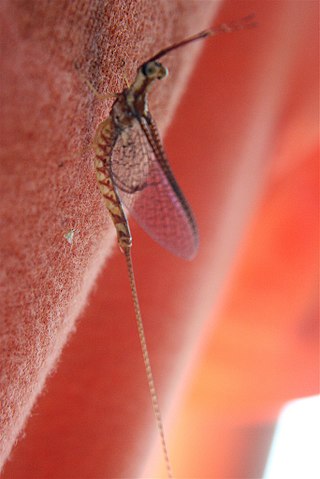
Hexagenia limbata, the giant mayfly, is a species of mayfly in the family Ephemeridae. It is native to North America where it is distributed widely near lakes and slow-moving rivers. The larvae, known as nymphs, are aquatic and burrow in mud and the adult insects have brief lives. They are often referred to as fish flies around the Great Lakes as they tend to cause the areas around water to smell like rotten fish.
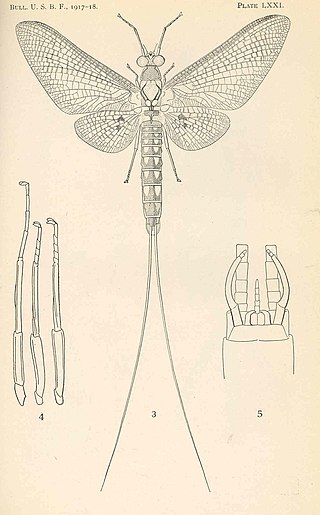
Hexagenia bilineata is a species of mayfly in the family Ephemeridae. It is native to North America where it is found in the Upper Mississippi Valley. Sometimes adults of this mayfly are so abundant as to cause a nuisance because of their enormous numbers. The larvae are aquatic and burrow in mud and the adult insects have brief lives.

Leptophlebia marginata, the sepia dun, is a species of mayfly in the family Leptophlebiidae. It is native to Europe and North America where it is distributed widely near lakes, ponds and slow-moving streams. The larvae, which are known as nymphs, are aquatic.
Ephemerella excrucians, the pale morning dun, is a species of spiny crawler mayfly in the family Ephemerellidae. It is found in all of Canada and the continental United States.
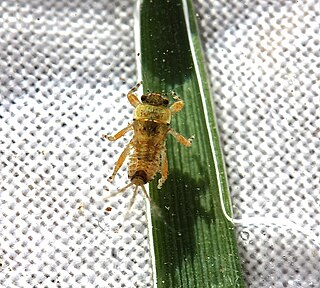
Ephemerella is a genus of spiny crawler mayflies in the family Ephemerellidae with a widespread distribution.

Ephemerella dorothea is a species of spiny crawler mayfly in the family Ephemerellidae. It is found in North America.
Invertebrate drift is the downstream transport of invertebrate organisms in lotic freshwater systems such as rivers and streams. The term lotic comes from the Latin word lotus, meaning "washing", and is used to describe moving freshwater systems. This is in contrast with lentic coming from the Latin word lentus, meaning slow or motionless that typically describe still or standing waters such as lakes, ponds, and swamps.
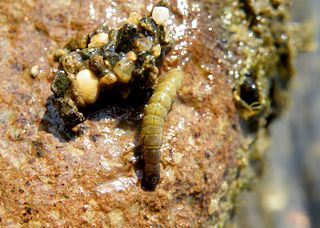
Aquatic macroinvertebrates are insects in their nymph and larval stages, snails, worms, crayfish, and clams that spend at least part of their lives in water. These insects play a large role in freshwater ecosystems by recycling nutrients as well as providing food to higher trophic levels.
Siphlonisca aerodromia, commonly known as the Tomah mayfly, is an extremely rare species and has only been documented less than 100 times. It was once thought to only known to occur in New York and Northern Maine, but has been since found more recently in eastern Canada as well. The Tomah mayfly is an endangered species and is listed as threatened in both New York and Maine. Its abundance is unknown. The Tomah mayfly is the only species within the monotypic genus Siphlonisca. The Tomah mayfly is a habitat specialist and an indicator species. Adults only live for a few days as they deposit eggs into rivers and streams. Nymphs hatch from eggs and migrate to the floodplains during springtime and following snow melt. They spend most of their lives in the floodplains, feeding on other aquatic invertebrates in order to grow rapidly. The Tomah mayfly was considered as a flagship species and led to the decision not to dam a stream and flood a sedge meadow and therefore conserve the ecosystem.
1 - Voshell, J.R. A Guide to Common Freshwater Invertebrates of North America. McDonald and Woodward. Blacksburg, Va. 2002.
2 - Merritt and Cummins. An Introduction to the Aquatic insects of North America 3rd ed. Kendall Hunt. Dubuque, Iowa. 1996.
3- Brady, Valerie. "Ephemeroptera- the mayflies." 4/27/16.












